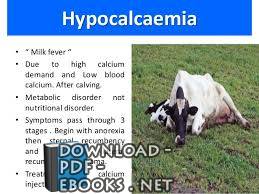📘 قراءة كتاب Factors Affecting the Success Rate of Treatment of Recumbent Dairy Cows Suffering from Hypocalcaemia أونلاين


Factors Affecting the Success Rate of Treatment of Recumbent Dairy Cows Suffering from Hypocalcaemia من كتب طب بيطرى
-hydroxybutyrate, total bilirubin, cholesterol,
urea, and the activities of ASAT, CK, and GLDH. Only cows
with hypocalcaemia entered the statistical analysis. Hypocal-
caemia was the major cause of recumbency in cows of the sec-
ond lactation or elder. Muscle damage was the second frequent
diagnose in recumbent cows and the major concomitant disease
in hypocalcaemic cows. The overall cure rate was between
89.4% and 94.8%. Calcium and phosphorus concentrations did
not have an influence on cure rate. Non-cured cows had higher
serum activities of CK (p<0.043) and ASAT (p<0.006).
Nevertheless, the activities of CK and ASAT were no good
predictors of treatment failure because of their low specificity
and the high cure rate of the cows in the five practices.
Introduction
Hypocalcaemia is still the major cause of dairy cows becoming
recumbent in the peripartal period (Shpigel et al., 2003; Gelfert
et al., 2004, 2005). The onset of lactation increases the calcium
requirement (Goff and Horst, 1997). If the mobilization of
calcium from the bones and intestine fails to compensate for
the loss of calcium in the milk, the plasma calcium concen-
trations will become too low to be able to support nerve and
muscle function (Goff and Horst, 1997; Goff, 2004). It is still
recommended to treat such animals with an intravenous
infusion of organic calcium solutions (Staufenbiel, 1999;
Martig, 2002). However, prior to the treatment of a recumbent
cow, a detailed clinical examination must be made in order to
exclude other possible causes of a recumbent cow. The main
differential diagnoses vary from disorders of the musculoskel-
etal system (traumatic injuries, bone fracture), neural disorders
(e.g. obturator paralysis) to metabolic diseases due to mineral
deficiencies (e.g. hypomagnesaemia, hypocalcaemia), energy
deficiency, or hepatic failure (Dirksen, 2002). Other possible
differential diagnoses are toxic metritis, toxic mastitis, ileus,
and shock due to the rupturing of the intestine, abomasal
ulcer, or generalized peritonitis (Dirksen, 2002; Hunt and
Blackwelder, 2002). Depending on the occurrence of a
disturbed sensorium or the disturbed general health of the
parturient cows, the possible differential diagnoses vary. In the
field, the possibilities of a detailed clinical examination are
often limited, in which the symptoms are either not clearly
visible or non-specific (Bostedt et al., 1979; Stolla et al., 2000).
Metzner and Klee (2005) showed that clinical signs are not
specific for a particular mineral deficiency (e.g. calcium or
phosphorus). They also found that the classical symptom of
hypocalcaemia, the disturbed sensorium, was found less severe
than in previous studies (Malz and Meyer, 1992). Therefore, a
given uncertainty remains after the clinical examination, in
which the examining veterinarian must choose the treatment
with the highest probability of success.
Recent papers have reported a decreased success rate after
the first treatment of the standard therapy (Meschke, 1997;
Abele and Wolf, 2000; Roesch, 2000; Stolla et al., 2000). Some
of them assume that the increased prevalence of recumbent
cows suffering from hypophosphataemia may contribute to the
impaired success rate (Abele and Wolf, 2000; Stolla et al.,
2000). Stolla et al. (2000) also assumed that the high preval-
ence of recumbent cows with increased creatinkinase (CK)
activity may contribute to the decreased success of the first
therapy, but he did not prove it. Other authors found
significant differences in hypocalcaemic cows with different
treatment outcomes (Gelfert et al., 2004). Unsuccessfully
treated cows had higher activities of CK and aspartate-
amino-transferase (ASAT) than the cured ones.
It is still unknown whether such factors accompanying the
hypocalcaemia have an impact on the curing rate of recumbent
dairy cows suffering from hypocalcaemia.
www.bl
حجم الكتاب عند التحميل : 476.7 كيلوبايت .
نوع الكتاب : PDF.
عداد القراءة:
اذا اعجبك الكتاب فضلاً اضغط على أعجبني و يمكنك تحميله من هنا:

شكرًا لمساهمتكم
شكراً لمساهمتكم معنا في الإرتقاء بمستوى المكتبة ، يمكنكم االتبليغ عن اخطاء او سوء اختيار للكتب وتصنيفها ومحتواها ، أو كتاب يُمنع نشره ، او محمي بحقوق طبع ونشر ، فضلاً قم بالتبليغ عن الكتاب المُخالف:
 قبل تحميل الكتاب ..
قبل تحميل الكتاب ..
يجب ان يتوفر لديكم برنامج تشغيل وقراءة ملفات pdf
يمكن تحميلة من هنا 'http://get.adobe.com/reader/'


 منصّة المكتبة
منصّة المكتبة